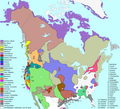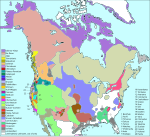Ficheiro:Langs N.Amer.png

Dimensões desta antevisão: 661 × 600 píxeis. Outras resoluções: 265 × 240 píxeis | 529 × 480 píxeis | 847 × 768 píxeis | 1 129 × 1 024 píxeis | 1 290 × 1 170 píxeis.
Imagem numa resolução maior (1 290 × 1 170 píxeis, tamanho: 599 kB, tipo MIME: image/png)
Histórico do ficheiro
Clique uma data e hora para ver o ficheiro tal como ele se encontrava nessa altura.
| Data e hora | Miniatura | Dimensões | Utilizador | Comentário | |
|---|---|---|---|---|---|
| atual | 17h28min de 20 de julho de 2019 |  | 1 290 × 1 170 (599 kB) | Denniss | Reverted to version as of 21:52, 1 March 2009 (UTC) |
| 16h54min de 13 de julho de 2019 |  | 1 290 × 1 170 (840 kB) | Thylacinus cynocephalus | Having colonial borders on an indigenous language map is offensive | |
| 21h52min de 1 de março de 2009 |  | 1 290 × 1 170 (599 kB) | Malus Catulus | optipng, pngout | |
| 14h31min de 22 de dezembro de 2006 |  | 1 290 × 1 170 (668 kB) | Mahahahaneapneap | pngcrushed | |
| 00h43min de 11 de novembro de 2006 |  | 1 290 × 1 170 (916 kB) | Ish ishwar | update | |
| 04h55min de 1 de abril de 2006 |  | 1 296 × 1 176 (678 kB) | Locke Cole | smaller file (pngout /f0 Langs_N.Amer.png /b4096) / Change: -315546 bytes ( 68% of original) | |
| 04h01min de 7 de janeiro de 2006 |  | 1 296 × 1 176 (986 kB) | Ish ishwar | adai,chimariko = unclassified; adjust uto-aztec, salinan, southern athabasc., muskogean; + Isla Ángel de la Guarda, Isla del Tiburón, Lake Okeechobee | |
| 21h24min de 9 de dezembro de 2005 |  | 1 318 × 1 195 (714 kB) | Ish ishwar | checker grid pattern to Chumash | |
| 06h12min de 6 de dezembro de 2005 |  | 1 318 × 1 195 (714 kB) | Ish ishwar | forgot seri, fix fam key | |
| 01h21min de 6 de dezembro de 2005 |  | 1 318 × 1 195 (712 kB) | Ish ishwar | update |
Utilização local do ficheiro
As seguintes 3 páginas usam este ficheiro:
Utilização global do ficheiro
As seguintes wikis usam este ficheiro:
- azb.wiki.x.io
- ca.wiki.x.io
- en.wiki.x.io
- History of the Americas
- North America
- Native Americans in the United States
- First Nations in Canada
- Linguistics and the Book of Mormon
- Lower Rio Grande Valley
- User:Ish ishwar
- Classification of the Indigenous languages of the Americas
- Wikipedia:Featured pictures thumbs/03
- Indigenous peoples of the Americas
- Wikipedia:Wikipedia Signpost/2005-12-26/Features and admins
- Wikipedia:Featured picture candidates/December-2005
- Wikipedia:Featured picture candidates/Indigenous language families north of Mexico
- User:Cyde/Featured pictures
- Talk:New World
- Wikipedia:Picture of the day/April 2006
- Wikipedia:POTD/April 1, 2006
- Wikipedia:Picture of the day/April 1, 2006
- Wikipedia:Today's second feature/April 1, 2006
- Portal:North America/Selected picture
- User talk:Wapcaplet/Archive 3
- Wikipedia:POTD column/April 1, 2006
- Wikipedia:POTD row/April 1, 2006
- User talk:Ish ishwar/2005talkpage
- Talk:Indigenous peoples of the Americas/Archive 1
- Portal:Maps/Selected picture
- List of language families
- Portal:Maps/Selected picture/20
- Wikipedia:Featured pictures/Diagrams, drawings, and maps/Maps
- User:Carcharoth/Arctic articles
- Portal:North America/Selected picture/5
- User:North8000
- Wikipedia:Reference desk/Archives/Language/2010 March 2
- Caddo Lake State Park
- Former colonies and territories in Canada
- Portal:Indigenous peoples of the Americas
- Pacific Northwest languages
- Wikipedia:Reference desk/Archives/Humanities/2012 July 4
- Talk:Early Slavs/Archive 1
- Wikipedia:Wikipedia Signpost/2013-06-05/News and notes
- Wikipedia:Wikipedia Signpost/Single/2013-06-05
- Canadian folklore
- User:Joelton Ivson/Gather lists/24453 – Indígenas nas Américas
- Portal:Maps
- User:Jmjosh90/sandbox/Archives/2022/March
- Wikipedia:Wikipedia Signpost/Single/2005-12-26
- User:Falcaorib/Canada, United States and Mexico
Ver mais utilizações globais deste ficheiro.

